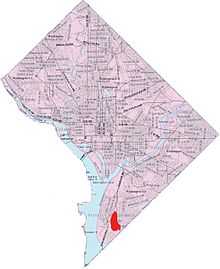Bellevue (Washington, D.C.)

Bellevue is a residential neighborhood in far SW Washington, DC. It is bounded by South Capitol Street to the north and east, Joliet and First Streets to the south, and the Potomac River to the west. A portion of Joint Base Anacostia-Bolling, the Naval Research Laboratory, the Blue Plains Advanced Wastewater Treatment Plant, Specialty Hospital of Washington-Hadley, the Metropolitan Police Academy, Washington Firefighters Training Center, a federal Job Corps center, and the Architect of the Capitol's Botanic Garden's production facility (greenhouse) are located in Bellevue. Mezzo-soprano opera singer Denyce Graves and country singer Roy Clark hail from the Bellevue neighborhood.
The area was named Bellevue by Thomas Grafton Addison, who purchased the land in 1795 and built a mansion there.[1] Old city maps and land permit records going back to 1880s designated this area of SW as labeled "Bell View"/"Bellevue"--"beautiful view" in French. Most residential development occurred in the 1950s and 1960s. Once a thriving commercial hub, Bellevue declined during the mass exodus of the middle class in the 1980s. It is on the cusp of revitalization. The most recent addition to the neighborhood is the $15M world class, David Adjaye designed edifice to replace the former Washington Highlands Library. The area surrounding the library was undeveloped farm land when Washington Highlands was built in 1959. The DC Board of Library Trustees voted in July 2011 to rename the new building Bellevue after the neighborhood where it is properly located. Over $150M in commercial mixed-use development is in the pipeline along South Capitol and Atlantic Streets, the heart of the Bellevue Business District.
References
- ↑ "Prehistoric Artifacts Open Window to the Past at NRL". U.S. Naval Research Laboratory. 28 July 2014. Retrieved 1 August 2014.
| |||||||||||||||
Coordinates: 38°49′39″N 77°00′32″W / 38.8274°N 77.0089°W